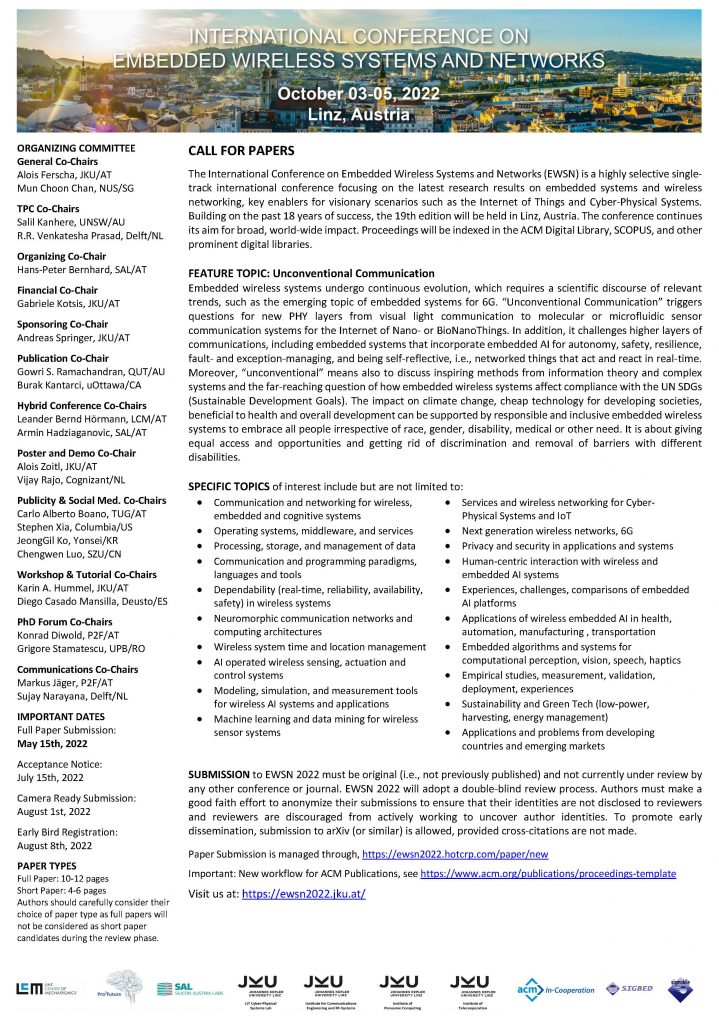The International Conference on Embedded Wireless Systems and Networks (EWSN) is a highly selective single-track international conference focusing on the latest research results on embedded systems and wireless networking, key enablers for visionary scenarios such as the Internet of Things and Cyber-Physical Systems. Building on the past 18 years of success, the 19th edition will be held in Linz, Austria. The conference continues its aim for broad, world-wide impact. Proceedings will be indexed in the ACM Digital Library, SCOPUS, and other prominent digital libraries.
FEATURE TOPIC: Unconventional Communication
Embedded wireless systems undergo continuous evolution, which requires a scientific discourse of relevant trends, such as the emerging topic of embedded systems for 6G. “Unconventional Communication” triggers questions of new PHY layers from visual light communication to molecular or microfluidic sensor communication systems spanning the Internet of Nano- or BioNanoThings. In addition, it challenges higher layers of communications, including embedded systems that incorporate embedded AI for autonomy, safety, resilience, fault- and exception-managing, and being self-reflective, i.e., networked things that act and react in real-time. Moreover, unconventional means also to discuss inspiring methods from information theory and complex systems and the far-reaching question of how embedded wireless systems affect compliance with the UN SDGs (Sustainable Development Goals). The impact on climate change, cheap technology for developing societies, beneficial to health and overall development can be supported by responsible and inclusive embedded wireless systems to embrace all people irrespective of race, gender, disability, medical or other need. It is about giving equal access and opportunities and getting rid of discrimination and removal of barriers with different disabilities.
SPECIFIC TOPICS of interest include but are not limited to:
- Communication and networking for wireless, embedded and cognitive systems
- Operating systems, middleware, and services
- Processing, storage, and management of data
- Communication and programming paradigms, languages and tools
- Dependability (real-time, reliability, availability, safety) in wireless systems
- Neuromorphic communication networks and computing architectures
- Wireless system time and location management
- AI operated wireless sensing, actuation and control systems
- Modeling, simulation, and measurement tools for wireless AI systems and applications
- Machine learning and data mining for wireless sensor system
- Services and wireless networking for Cyber-Physical Systems and IoT
- Next generation wireless networks, 6G
- Privacy and security in applications and systems
- Human-centric interaction with wireless and embedded AI systems
- Experiences, challenges, comparisons of embedded AI platforms
- Applications of wireless embedded AI in health, automation, manufacturing , transportation
- Embedded algorithms and systems for computational perception, vision, speech, haptics
- Empirical studies, measurement, validation, deployment, experiences
- Sustainability and Green Tech (low-power, harvesting, energy management)
- Applications and problems from developing countries and emerging markets
SUBMISSION to EWSN 2022 must be original (i.e., not previously published) and not currently under review by any other conference or journal. EWSN 2022 will adopt a double-blind review process. Authors must make a good faith effort to anonymize their submissions to ensure that their identities are not disclosed to reviewers and reviewers are discouraged from actively working to uncover author identities. To promote early dissemination, submission to arXiv (or similar) is allowed, provided cross-citations are not made.
Paper Submission is managed through https://ewsn2022.hotcrp.com/paper/new
FORMATTING REQUIREMENTS Both full (10-12 pages) and short papers (4-6 pages) are welcome. Authors should carefully consider this choice as full papers will not be considered as short paper candidates during the review phase. Pages must use 8.5″ x 11″ (letter) two-column format, using 10-point type on 11-point leading, with a maximum text block of 7″ wide x 9″ deep with an inter-column spacing of .25″. The page limits include figures, tables, and references.
Authors may use the LaTex templates provided here. (right-click – save as)
Call for Papers PDF (click link or thumbnail)
